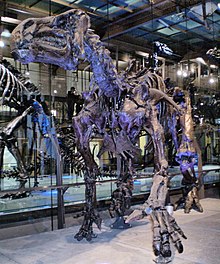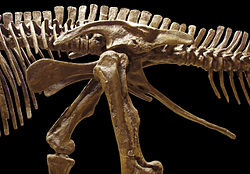Ornithischia
Ornithischia is an extinct clade of mainly herbivorous dinosaurs characterized by a pelvic structure superficially similar to that of birds.
| Ornithischia Temporal range: Upper Triassic–Upper Cretaceous, 228–66 mya
| |
|---|---|

| |

| |
| Pachyrhinosaurus and Iguanodon, types of ornithischians | |
| Scientific classification | |
| Kingdom: | |
| Phylum: | |
| Class: | |
| Superorder: | |
| Order: | Ornithischia Seeley, 1888
|

The name Ornithischia, or "bird-hipped", reflects this similarity and is derived from the Greek stem ornith- (ὀρνιθ-), meaning "of a bird", and ischion (ἴσχιον), plural ischia, meaning "hip joint". However, birds are only distantly related to this group as birds are theropod dinosaurs.
Overview
changeOrnithischians with well known anatomical adaptations include the ceratopsians or "horn-faced" dinosaurs, the pachycephalosaurs or "thick-headed" dinosaurs, the armored dinosaurs (Thyreophora) such as stegosaurs and ankylosaurs, and the ornithopods.
There is strong evidence that certain groups of ornithischians lived in herds, often segregated by age group, with juveniles forming their own flocks separate from adults.
Some were at least partially covered in filamentous pelts, and there is much debate over whether these filaments found in specimens of Tianyulong, Psittacosaurus, and Kulindadromeus may have been primitive feathers.
Fossil works
changeThey are known as the 'bird-hipped' dinosaurs because of their hip structure. However, birds actually descended from the 'lizard-hipped' dinosaurs, the Saurischia. The name "Ornithischia" means "bird-hipped," and birds also have pelvises in which the pubis points backwards.
An alternative name for the order is the Predentata, because all of them are beaked herbivorous dinosaurs. The beak is in front of the jaw-bone, the dentary, so it is a 'predentary'. The upper half of the beak is the 'premaxilla' on the end of the upper jaw. The beak is a key adaptation for cropping plants for their food.
Their original (basal) form of locomotion was bipedal. However, from early in their evolutionary history, they were capable of both bipedal and quadrupedal locomotion.[1] Several groups became entirely quadrupedal.[2]
A new hypothesis of dinosaur relationships might upset this summary.[3]
The ornithischia has two sub-orders:
- Thyreophora: the armoured dinosaurs: Ankylosaurs and Stegosaurs.
- Cerapoda: the duck-billed and horned dinosaurs.
Plants
changeTheir vegetarian diet included:
- Seed ferns: Pteridospermatophyta. Upper Triassic, Jurassic.
- Cycads and other woody seed plants, common during Mesozoic period.
- Gymnosperms (conifers): Jurassic, Cretaceous.
- Angiosperms (flowering plants): Cretaceous
- Algae in the form of seaweed: no direct evidence, but likely.
This group of dinosaurs would not be able to reach the taller conifers. The other main group of vegetarian dinosaurs, the sauropodomorphs, were specialists able to reach vegetation on the tall trees.
Related pages
changeReferences
change- ↑ Wilson J.A; Marsicano C.A. & Smith R.M.H. 2009. Dynamic locomotor capabilities revealed by early dinosaur trackmakers from southern Africa. PLoS ONE 4(10) [1]
- ↑ Fastovsky, David E. & Weishampel, David B. 2012. Dinosaurs: a concise natural history. Cambridge: Cambridge University Press. ISBN 978-1107276468
- ↑ Baron M.G; Norman D.B. & Barrett P.M. 2017. A new hypothesis of dinosaur relationships and early dinosaur evolution. Nature 543, 501–506.